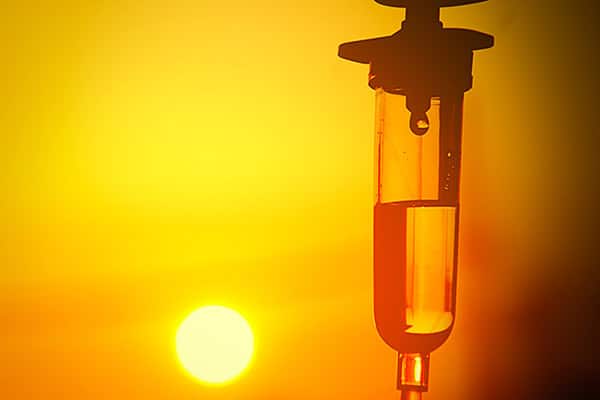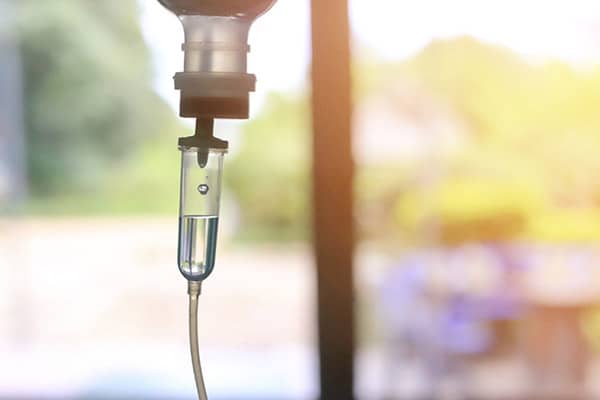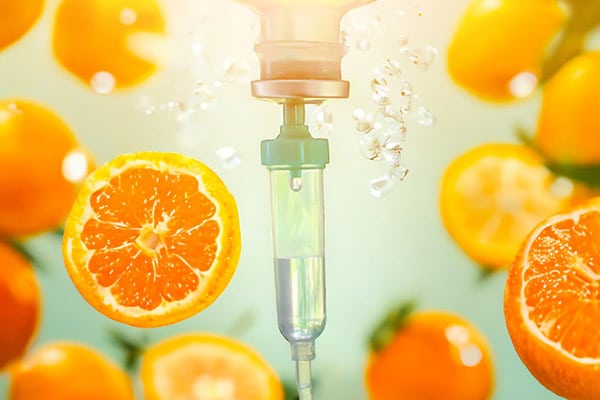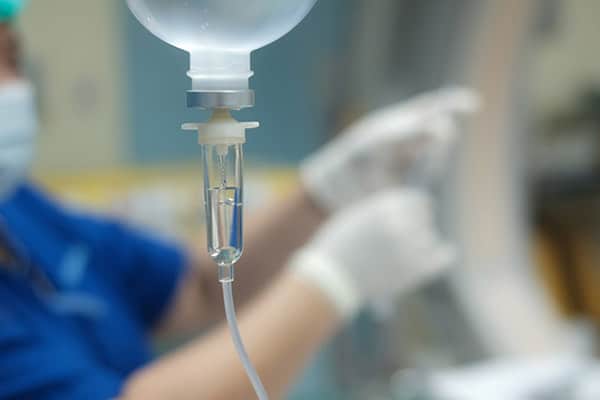What is IV Therapy?
Here at Recover Restore Revive we understand that vitamin deficiencies play a large role in a person’s overall health. Our line of IV therapy options target several of these deficiencies depending on the IV Therapy that you choose to undergo. Below is a list of the common vitamins found within our bodies along with their role in the process of maintaining homeostasis. Within each vitamin, there is also a list of symptoms associated with being deficient and common medical conditions associated with each.
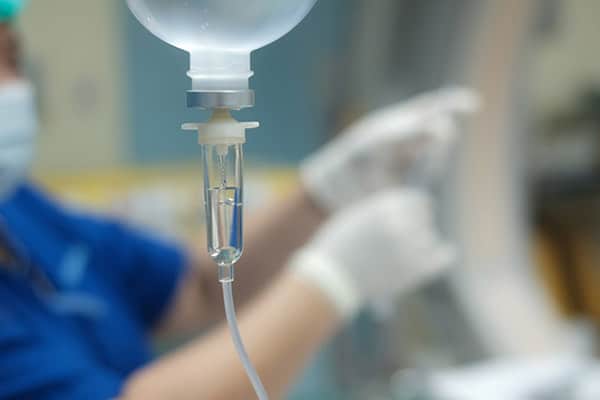
Vitamin B1, also called thiamine or thiamin, is one of 8 B vitamins. All B vitamins help the body convert food (carbohydrates) into fuel (glucose), which the body uses to produce energy. Vitamin B1 helps the body metabolize fats and protein and are also needed for a healthy liver, skin, hair, and eyes. They also help the nervous system function properly and are needed for good brain function.
All B vitamins are water soluble, meaning that the body does not store them.
Like other B-complex vitamins, thiamine is sometimes called an “anti-stress” vitamin because it may strengthen the immune system and improve the body’s ability to withstand stressful conditions. It is named B1 because it was the first B vitamin discovered.
Thiamine is found in both plants and animals and plays a crucial role in certain metabolic reactions. Your body needs it to form adenosine triphosphate (ATP), which every cell of the body uses for energy.
It is rare to be deficient in thiamine, although alcoholics, people with Crohn disease, anorexia, and those undergoing kidney dialysis may be deficient. Symptoms of thiamine deficiency are:
- Headache
- Nausea
- Fatigue
- Irritability
- Depression
- Abdominal discomfort
People with thiamine deficiency also have trouble digesting carbohydrates. This allows a substance called pyruvic acid to build up in the bloodstream, causing a loss of mental alertness, difficulty breathing, and heart damage, a disease known as beriberi.
Vitamin B2, also called riboflavin, is one of 8 B vitamins. mIn addition to producing energy for the body, riboflavin works as an antioxidant, fighting damaging particles in the body known as free radicals. Free radicals can damage cells and DNA, and may contribute to the aging process, as well as the development of a number of health conditions, such as heart disease and cancer. Antioxidants, such as riboflavin, can fight free radicals and may reduce or help prevent some of the damage they cause.
Riboflavin is also needed to help the body change vitamin B6 and folate into forms it can use. It is also important for growth and red blood cell production.
Most healthy people who eat a well-balanced diet get enough riboflavin. However, elderly people and alcoholics may be at risk for riboflavin deficiency because of poor diet. Symptoms of riboflavin deficiency include:
- Fatigue
- Slowed growth
- Digestive problems
- Cracks and sores around the corners of the mouth
- Swollen magenta-colored tongue
- Eye fatigue
- Swelling and soreness of the throat
- Sensitivity to light
Inositol hexanicotinate; Niacin; Niacinamide; Nicotinamide; Nicotinic acid
Vitamin B3 is one of 8 B vitamins. It is also known as niacin (nicotinic acid) and has 2 other forms, niacinamide (nicotinamide) and inositol hexanicotinate, which have different effects from niacin.
Niacin also helps the body make various sex and stress-related hormones in the adrenal glands and other parts of the body. Niacin helps improve circulation, and it has been shown to suppress inflammation.
You can meet all of your body’s needs for B3 through diet. It is rare for anyone in the developed world to have a B3 deficiency. In the U.S., alcoholism is the main cause of vitamin B3 deficiency.
Symptoms of mild B3 deficiency include:
- Indigestion
- Fatigue
- Canker sores
- Vomiting
- Poor circulation
- Depression
Severe deficiency can cause a condition known as pellagra. Pellagra is characterized by cracked, scaly skin, dementia, and diarrhea. It is generally treated with a nutritionally balanced diet and niacin supplements. Niacin deficiency also causes burning in the mouth and a swollen, bright red tongue.
Very high doses of B3, available by prescription, have been studied to prevent or improve symptoms of the following conditions. However, at high doses niacin can be toxic. You should not take doses higher than the Recommended Daily Allowance (RDA) except under your doctor’s supervision. Researchers are trying to determine if inositol hexanicotinate has similar benefits without serious side effects. But results are inconclusive.
Vitamin B5, also called pantothenic acid, is one of 8 B vitamins. In addition to playing a role in the breakdown of fats and carbohydrates for energy, vitamin B5 is critical to the manufacture of red blood cells, as well as sex and stress-related hormones produced in the adrenal glands, small glands that sit atop the kidneys. Vitamin B5 is also important in maintaining a healthy digestive tract, and it helps the body use other vitamins, particularly B2 (also called riboflavin). It is sometimes called the “anti-stress” vitamin, but there is no concrete evidence whether it helps the body withstand stress.
Your body needs pantothenic acid to synthesize cholesterol. A derivative of pantothenic acid called pantethine is being studied to see if it may help lower cholesterol levels in the body.
Vitamin B5 deficiency is rare, but may include symptoms such as fatigue, insomnia, depression, irritability, vomiting, stomach pains, burning feet, and upper respiratory infections.
Vitamin B6 is a water-soluble vitamin. Water-soluble vitamins dissolve in water so the body cannot store them. Leftover amounts of the vitamin leave the body through the urine. Although the body maintains a small pool of water-soluble vitamins, they have to be taken regularly.
Lack of vitamin B6 in the body is uncommon. It can occur in people with kidney failure, liver disease, or alcohol dependence.
Function
Vitamin B6 helps the body to:
- Make antibodies. Antibodies are needed to fight many viruses, infections, and other diseases.
- Maintain normal nerve function.
- Make hemoglobin. Hemoglobin carries oxygen in the red blood cells to the tissues. A vitamin B6 deficiency can cause a form of anemia.
- Break down proteins. The more protein you eat, the more vitamin B6 you need.
- Keep blood sugar (glucose) in normal ranges.
Side Effects
Large doses of vitamin B6 can cause:
- Difficulty coordinating movement
- Numbness
- Sensory changes
Deficiency of this vitamin can cause:
- Confusion
- Depression
- Irritability
- Mouth and tongue sores also known as glossitis
- Peripheral neuropathy
(Vitamin B6 deficiency is not common in the United States.)
Hydroxocobalamin: a manufactured version of vitamin B12
Methylcobalamin: active form of B12
Cyanocobalamin: manufactured version of B12
Vitamin B12 is a water-soluble vitamin. Water-soluble vitamins dissolve in water. After the body uses these vitamins, leftover amounts leave the body through the urine.
The body can store vitamin B12 for years in the liver.
Function
Vitamin B12, like the other B vitamins, is important for protein metabolism. It helps in the formation of red blood cells and in the maintenance of the nervous system.
Side Effects
Vitamin B12 deficiency occurs when the body does not get or is not able to absorb the amount of the vitamin that the body needs.
Deficiency is most common in people who:
- Are over the age of 50
- Follow vegetarian or vegan diet
- Have had stomach or intestinal surgery, such as weight loss surgery
- Have digestive system conditions such as celiac disease or Crohn disease
Talk to your health care provider about taking vitamin B12 supplements.
Low levels of B12 can cause:
- Anemia
- Dementia
- Loss of balance
- Numbness or tingling in the arms and legs
- Weakness
Vitamin H, more commonly known as biotin, is part of the B complex group of vitamins. Your body needs biotin to metabolize carbohydrates, fats, and amino acids, the building blocks of protein. Biotin is often recommended for strengthening hair and nails, and it’s found in many cosmetic products for hair and skin.
It’s rare to be deficient in biotin. Symptoms include hair loss, dry scaly skin, cracking in the corners of the mouth (called cheilitis), swollen and painful tongue that is magenta in color (glossitis), dry eyes, loss of appetite, fatigue, insomnia, and depression. People who have been on parenteral nutrition — nutrition given intravenously — for a long period of time, those taking antiseizure medication or antibiotics long-term, and people with conditions like Crohn’s disease that make it hard to absorb nutrients, are more likely to be deficient in biotin.
There are not many good quality studies evaluating biotin. Many of its proposed uses are based on weak evidence or case reports.
Every organ in the body, especially the heart, muscles, and kidneys, needs magnesium. This mineral also contributes to the makeup of teeth and bones. Magnesium activates enzymes, contributes to energy production, and helps regulate levels of calcium, copper, zinc, potassium, vitamin D, and other important nutrients in the body.
You can get magnesium from many foods. However, most people in the U.S. probably do not get as much magnesium as they should from their diet. Foods rich in magnesium include whole grains, nuts, and green vegetables. Green leafy vegetables are particularly good sources of magnesium.
Although you may not get enough magnesium from your diet, it is rare to be deficient in magnesium. However, certain medical conditions can upset the body’s magnesium balance. For example, an intestinal virus that causes vomiting or diarrhea can cause a temporary magnesium deficiency. Some health conditions can lead to deficiencies, including:
- Gastrointestinal diseases, such as irritable bowel syndrome (IBS) and ulcerative colitis
- Diabetes
- Pancreatitis
- Hyperthyroidism (high thyroid hormone levels)
- Kidney disease
- Taking diuretics
Other factors that can lower magnesium levels include:
- Drinking too much coffee, soda, or alcohol
- Eating too much sodium (salt)
- Heavy menstrual periods
- Excessive sweating
- Prolonged stress
Symptoms of magnesium deficiency may include:
- Agitation and anxiety
- Restless leg syndrome (RLS)
- Sleep disorders
- Irritability
- Nausea and vomiting
- Abnormal heart rhythms
- Low blood pressure
- Confusion
- Muscle spasm and weakness
- Hyperventilation
- Insomnia
- Poor nail growth
- Seizures
Manganese is a trace mineral that is present in tiny amounts in the body. It is found mostly in bones, the liver, kidneys, and pancreas. Manganese helps the body form connective tissue, bones, blood clotting factors, and sex hormones. It also plays a role in fat and carbohydrate metabolism, calcium absorption, and blood sugar regulation. Manganese is also necessary for normal brain and nerve function.
Manganese is a component of the antioxidant enzyme superoxide dismutase (SOD), which helps fight free radicals. Free radicals occur naturally in the body but can damage cell membranes and DNA. They may play a role in aging, as well as the development of a number of health conditions, including heart disease and cancer. Antioxidants, such as SOD, can help neutralize free radicals and reduce or even help prevent some of the damage they cause.
Low levels of manganese in the body can contribute to infertility, bone malformation, weakness, and seizures. It is fairly easy to get enough manganese in your diet — this nutrient is found in whole grains, nuts, and seeds — but some experts estimate that as many as 37% of Americans do not get the recommended dietary intake (RDI) of manganese in their diet. The American diet tends to contain more refined grains than whole grains, and refined grains only provide half the amount of manganese as whole grains.
However, too much manganese in the diet could lead to high levels of manganese in the body tissues. Abnormal concentrations of manganese in the brain, especially in the basal ganglia, are associated with neurological disorders similar to Parkinson’s disease. Early life manganese exposure at high levels, or low levels, may impact neurodevelopment. Elevated manganese is also associated with poor cognitive performance in school children.
Copper, an essential mineral, is naturally present in some foods and is available as a dietary supplement. It is a cofactor for several enzymes (known as cuproenzymes) involved in energy production, iron metabolism, neuropeptide activation, connective tissue synthesis, and neurotransmitter synthesis. One abundant cuproenzyme is ceruloplasmin (CP), which plays a role in iron metabolism and carries more than 95% of the total copper in healthy human plasma. Copper is also involved in many physiologic processes, such as angiogenesis; neurohormone homeostasis; and regulation of gene expression, brain development, pigmentation, and immune system functioning. In addition, defense against oxidative damage depends mainly on the copper-containing superoxide dismutase.
Only small amounts of copper are typically stored in the body, and the average adult has a total body content of 50–120 mg copper. Most copper is excreted in bile, and a small amount is excreted in urine. Total fecal losses of copper of biliary origin and nonabsorbed dietary copper are about 1 mg/day. Copper levels in the body are homeostatically maintained by copper absorption from the intestine and copper release by the liver into bile to provide protection from copper deficiency and toxicity.Copper status is not routinely assessed in clinical practice, and no biomarkers that accurately and reliably assess copper status have been identified. Human studies typically measure copper and cuproenzyme activity in plasma and blood cells because individuals with known copper deficiency often have low blood levels of copper and CP. However, plasma CP and copper levels can be influenced by other factors, such as estrogen status, pregnancy, infection, inflammation, and some cancers [2]. Normal serum concentrations are 10–25 mcmol/L (63.5–158.9 mcg/dL) for copper and 180–400 mg/L for CP.
Methionine is an essential amino acid found in protein food sources such as meat and dairy. Your body cannot make methionine, so you must get it from food or supplements. It is important for many functions in the body, including building new proteins, making DNA, and normal tissue growth and repair.
There are two types of methionine: L-methionine (which is naturally occurring and usually found in supplements) and D-methionine. Each contains the same chemical makeup, but the molecules are mirror images. A mixture of the two is called DL-methionine.
There is no suggested dose for methionine supplements, but you should get about 14 milligrams (mg) daily per kilogram (Kg) of bodyweight.
Used for the treatment of acetaminophen overdose, may help improve liver damage and may support cancer prevention. Other uses include nourishing hair, skin and nails, slowing down cell aging, protecting cells from pollutants, assisting with absorption of other nutrients and aiding in the detoxification of heavy metals.
Side effects
- Nausea
- Vomiting
- Drowsiness
- Irritability
Inositol is a type of sugar that influences both the body’s insulin response and several hormones associated with mood and cognition. It’s often referred to as vitamin B8, but it is not actually a vitamin.
Inositol is found naturally in cantaloupe, citrus fruit, and many fiber-rich foods (such as beans, brown rice, corn, sesame seeds, and wheat bran). It is also sold in supplement form and used as a complementary therapy to treat a wide range of medical conditions, including metabolic and mood disorders.
D-chiro-inositol, inositol hexaphosphate (often referred to as “IP6”), and the compound myo-inositol are the most widely used inositol supplements. They are generally considered safe if taken appropriately.
Inositol plays an important role in cell growth and functioning. Some research has found that inositol may have a number of health benefits, including relieving symptoms of depression. Some research also indicates that inositol might help relieve anxiety and symptoms of panic disorder.
Other potential benefits include:
- Lowering the risk of metabolic syndrome
- Lowering high cholesterol
- Regulating processing insulin
- Reducing the risk of gestational diabetes
- Relieving symptoms of Polycystic ovarian syndrome (PCOS)
Side effects
- Nausea
- Stomach pain
- Tiredness
- Headache
- Dizziness
Choline is an essential nutrient that is naturally present in some foods and available as a dietary supplement. Choline is a source of methyl groups needed for many steps in metabolism. The body needs choline to synthesize phosphatidylcholine and sphingomyelin, two major phospholipids vital for cell membranes. Therefore, all plant and animal cells need choline to preserve their structural integrity. In addition, choline is needed to produce acetylcholine, an important neurotransmitter for memory, mood, muscle control, and other brain and nervous system functions., Choline also plays important roles in modulating gene expression, cell membrane signaling, lipid transport and metabolism, and early brain development.
Humans can produce choline endogenously in the liver, mostly as phosphatidylcholine, but the amount that the body naturally synthesizes is not sufficient to meet human needs. As a result, humans must obtain some choline from the diet. Premenopausal women might need less choline from the diet than children or other adults because estrogen induces the gene that catalyzes the biosynthesis of choline [4]. When a diet is deficient in folate, a B-vitamin that is also a methyl donor, the need for dietary choline rises because choline becomes the primary methyl donor.
The most common sources of choline in foods are the fat-soluble phospholipids phosphatidylcholine and sphingomyelin as well as the water-soluble compounds phosphocholine, glycerolphosphocholine, and free choline. When these choline-containing compounds are ingested, pancreatic and mucosal enzymes liberate free choline from about half of the fat-soluble forms and some water-soluble forms. Free choline, phosphocholine, and glycerophosphocholine are absorbed in the small intestine, enter the portal circulation, and are stored in the liver, where they are subsequently phosphorylated and distributed throughout the body to make cell membranes. The remaining fat-soluble phospholipids (phosphatidylcholine and sphingomyelin) are absorbed intact, incorporated into chylomicrons, and secreted into the lymphatic circulation, where they are distributed to tissues and other organs, including the brain and placenta.
Choline status is not routinely measured in healthy people. In healthy adults, the concentration of choline in plasma ranges from 7 to 20 mcmol/L. According to one study, the range is 7–9.3 mcmol/L in fasting adults. Plasma choline levels do not decline below 50% of normal, even in individuals who have not eaten for more than a week. This may be due to the hydrolysis of membrane phospholipids, a source of choline, to maintain plasma choline concentrations above this minimal level, or to endogenous synthesis.
Choline deficiency can cause muscle damage, liver damage, and nonalcoholic fatty liver disease (NAFLD or hepatosteatosis. Although most people in the United States consume less than the AI of choline, frank choline deficiency in healthy, nonpregnant individuals is very rare, possibly because of the contribution of choline that the body synthesizes endogenously.
Carnitine, derived from an amino acid, is the generic term for several compounds, including L-carnitine, acetyl-L-carnitine, and propionyl-L-carnitine. Carnitine is naturally present in many foods—especially foods of animal origin—and is available as a dietary supplement. Carnitine is also synthesized endogenously in the liver, kidneys, and brain from the amino acids lysine and methionine. Carnitine is a conditionally essential nutrient because the requirements for carnitine exceed an individual’s ability to synthesize this nutrient only under certain conditions (e.g., premature birth or kidney disfunction).
Carnitine plays a critical role in energy production. It is an essential cofactor that helps transport long-chain fatty acids into the mitochondria so that they can be oxidized to produce energy in the form of adenosine triphosphate (ATP). Carnitine also helps transport some toxic compounds out of the mitochondria.
Carnitine is concentrated in tissues that oxidize fatty acids as a dietary fuel. About 95% of total body carnitine is stored in heart and skeletal muscle. Most of the remainder is stored in the liver and kidney, and circulating plasma contains only about 0.5% of the body’s carnitine. Excess plasma carnitine is excreted in urine.
The body needs about 15 mg/day of carnitine from a combination of dietary sources and endogenous synthesis. Foods of animal origin provide most of the carnitine in American diets. A typical omnivorous diet provides about 24 to 145 mg carnitine daily for a person weighing 165 pounds. In contrast, a vegan diet provides about 1.2 mg carnitine.
Endogenous carnitine synthesis does not appear to be affected by dietary carnitine intake or carnitine excretion and is sufficient to meet the carnitine needs of healthy people. A person weighing 165 lb who follows a strict vegetarian diet, for example, synthesizes approximately 14.4 mg/day carnitine.
Carnitine status is not routinely assessed in clinical practice, but it can be determined by measuring circulating carnitine. A plasma free carnitine concentration of 20 mcmol/L or less, or a total carnitine concentration of 30 mcmol/L or less, is abnormally low.. The ratio of acyl-L-carnitine ester to free L-carnitine can also be used to assess carnitine status because under normal conditions most carnitine is in the free unesterified form. A ratio of 0.4 or greater in plasma or serum indicates abnormal carnitine metabolism and suggests carnitine insufficiency.
Carnitine Deficiency
Two types of carnitine deficiency states exist. Primary carnitine deficiency is a genetic disorder of the cellular carnitine transporter system that causes a shortage of carnitine within cells. Primary carnitine deficiency usually presents during infancy or early childhood. It can result in epilepsy and encephalopathy in infants; seizures, irregular heartbeat, and breathing problems in adolescents and young adults; and myopathy, rhabdomyolysis, cardiomyopathy, or sudden death in older people. Although some individuals with primary carnitine deficiency do not have symptoms, all affected people have an increased risk of heart failure, hepatic disorders, and coma.
Secondary carnitine deficiency results from certain disorders (such as chronic renal failure) that reduce endogenous carnitine synthesis or increase its excretion or from chronic use of pivalate-containing medications that reduce carnitine absorption or increase its excretion. Signs and symptoms of secondary carnitine deficiency include hyperammonemic encephalopathy (malaise, seizures, and decreased consciousness caused by elevated ammonia levels), hypoglycemia, hypoketonemia (low level of ketones in the blood), dicarboxylic aciduria (increased concentrations of dicarboxylic acids in the urine), hyperuricemia (excess uric acid in the blood), muscle weakness, myoglobinuria (excess myoglobin in the urine), cardiomyopathy, and sudden death.
Primary and secondary carnitine deficiency can be resolved with high doses (20–200 mg)
Glutathione is one of the most important substances in the body, but if you’re like most people, you’ve probably never even heard of it. So, in this article, we’re going to talk about what glutathione is, why you need it, and what you can do to increase levels of glutathione and boost your health.
Composed of the amino acids cysteine, glutamic acid, and glycine, gamma-glutamyl-L-cysteinyl glycine, or glutathione (GSH), is a tripeptide thiol that’s present in large concentrations in the cytosol and organelles of every cell. Glutathione plays such an important role in antioxidant defense that it’s known as the body’s master antioxidant.
Not only is the role of glutathione in protecting the body from oxidative stress not to be overstated, but this powerful antioxidant can also regenerate other antioxidants, including vitamins C and E.
Glutathione also plays an important role in the detoxification process via its use as a cofactor. For example, it’s required by peroxidase enzymes for the neutralization of harmful peroxides—including lipid peroxides, which form when lipids interact with free radicals.
In addition, it’s used by transhydrogenases to stop the oxidation of DNA and proteins and by glutathione S-transferase (GST) to bind to toxins and xenobiotics.
But as important as neutralizing reactive oxygen species like free radicals, aiding detoxification, staving off oxidative damage, and regenerating other antioxidants are, they aren’t the only functions glutathione has.
Glutathione also helps the body metabolize nutrients from the foods we eat, aids energy production, and assists in the regulation of cellular processes, including those that control:
- Gene expression
- Protein and DNA synthesis
- Cell proliferation and apoptosis
- Immune system response
And because it contains the sulfur-bearing amino acid cysteine, glutathione naturally binds to heavy metals like mercury (via glutathione S-transferase) and prevents them from entering the body’s cells, where they can cause organ damage.
Glutathione deficiency
Because glutathione is constantly interacting with free radicals and becoming oxidized, glutathione production never stops. During this process, glutathione transforms into glutathione disulfide, or oxidized glutathione (GSSG), and is regenerated—with the help of an energy source like glucose—by the enzyme glutathione reductase (GR).
When the body is healthy, this glutathione synthesis is carried out smoothly. However, genetic mutations and modern ills like poor diet, chronic stress, and exposure to toxins can affect the body’s ability to manufacture adequate levels of glutathione and lead to glutathione deficiency.
With all the health benefits associated with glutathione, it makes sense that a deficiency in this important antioxidant would be associated with a number of negative side effects.
And it is.
In fact, glutathione deficiency has been linked to a number of health issues, including:
- Alzheimer’s disease
- Parkinson’s disease
- Cystic fibrosis
- Diabetes
- Heart disease
- Liver disease
- Cataracts
- Autism spectrum disorders
- HIV
However, the good news is that there are several strategies that can help you increase your glutathione levels.


